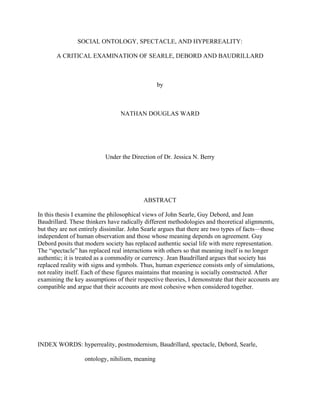This document provides an overview and analysis of the philosophical views of John Searle, Guy Debord, and Jean Baudrillard regarding the nature of meaning and social reality. It argues that while these thinkers have different methodologies and perspectives, their accounts are conceptually compatible and most cohesive when considered together in a synthetic view. The document begins by outlining Searle's view that social reality and meaning are socially constructed but depend on an objective physical reality. It then discusses Debord's concept of the "spectacle" replacing authentic social interactions and Baudrillard's idea of society replacing reality with simulations. The document proposes that together these perspectives provide a more comprehensive understanding of how meaning is constructed and its implications in modern society







![2
“hyperreality” and how it arises from certain conditions created by postmodern capitalism.
Baudrillard shares Debord’s concern that we can no longer distinguish between what is and is
not real. In Searle’s terms, we can no longer distinguish mind independent facts from mind
dependent facts. Debord and Baudrillard both focus upon ways in which meaning in society,
which is what Searle would call social reality, is or could be eroded and lead to negative
consequences for human well-being.
My goal is to show that, at their core, Searle, Debord, and Baudrillard are all concerned
with the status of meaning in society, how it is created, remains stable, and whether or not it is
being eroded. My central assumption is that their respective accounts are neither
incommensurable nor necessarily opposed. With these considerations in mind, I will develop my
own arguments based upon the synthesis of the above accounts and advance my own
conclusions. First, because it is necessary to thoroughly grasp Searle’s ontology and his basic
propositions to illuminate how and why Debord and Baudrillard’s accounts are consistent with
his, I will provide an overview of Searle’s account, followed by Debord’s and ending with
Baudrillard’s.
II. Searle on Meaning
Searle subscribes to epistemological realism—the proposition that a “real” world exists
independently of the ideas and perceptions of conscious entities—and a correspondence theory
of truth—the proposition that a statement is true if it corresponds to the facts in the “real” world.1
1
Smith explains Searle’s specific stance succinctly; he says, “The thesis of basic
[epistemological] realism is not, in Searle’s eyes, a theoretical proposition in its own right.
Rather—and in this, he echoes Thomas Reid—it sanctions the very possibility of our making
theoretical assertions in science, just as it sanctions the attempt to build a comprehensive theory
in philosophy. This is because the theories that we develop are intelligible only as](https://image.slidesharecdn.com/5f03b894-38ae-47d1-ab31-6558a944b426-150612184841-lva1-app6891/85/NW-THESIS-DRAFT-FINAL-format-preserving-8-320.jpg)







































